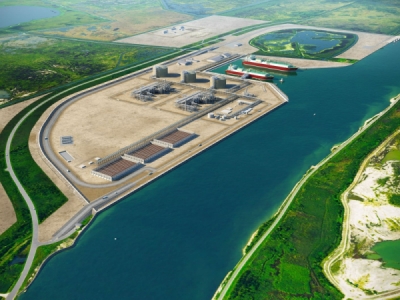
Posted on April 22, 2019
Washington — The Federal Energy Regulatory Commission on Thursday granted certificate approval to the Driftwood LNG and Port Arthur LNG export terminals, bolstering prospects for two projects in the second wave of US LNG development.
As Commissioner Bernard McNamee noted, after two years without approving an LNG project, FERC in two months has advanced three export projects that together add the capacity to export 7.3 Bcf/d of LNG.
With the 3-1 votes Thursday, the commission was again able to act despite recent differences among Democratic and Republican commissioners over greenhouse gas emissions considerations. It was unclear whether an agreement on GHG emissions reached in February when FERC approved the Venture Global Calcasieu Pass LNG project would prove durable as a model for other projects.
NOTE OF CAUTION
Commissioner Cheryl LaFleur, a key swing vote in favor, injected a note of caution at FERC’s Thursday meeting.
“In spite of the fact that we have reached compromises on some [GHG] language, it’s getting harder, not easier, to do that in these cases.” As courts continue to speak on that matter, she added, “I don’t understand why we do not act proactively together to work to address the issues in our cases. … I think we’re just waiting for the court to impose requirements on us.”
On the sidelines of FERC’s monthly meeting, LaFleur said it was harder to get on board because of cumulative impacts as FERC acts on more, larger LNG projects, and because of her frustration with FERC’s approach to the National Environmental Policy Act.
Chairman Neil Chatterjee hailed the approvals as important not only to the US economy but to partners around the globe. He called it a “very good day for America and a very bad day for Russia.” He remained optimistic the compromises would continue to allow a path forward for other pending projects.
One key to winning LaFleur’s vote in the Driftwood case was an agreement to respond to a commenter inquiring about cumulative GHG emissions. Commissioner Richard Glick continued to dissent, and said the “dirty little secret” is that following the current approach, FERC would never consider GHG emissions significant no matter how large the emissions. “I think everyone knows what’s going on here,” he said, noting that FERC requires mitigation for a host of other environmental effects. “This is climate change. That’s why we just can’t talk about it.”
Acting Thursday, FERC signed off on the roughly 27.6 million mt/year, or 3.6 Bcf/d, Driftwood LNG facility in Louisiana, proposed by Tellurian, along with Tellurian’s 96-mile pipeline intended to feed 4 Bcf/d of natural gas to the facility (CP17-117, CP17-118).
Also approved was Sempra Energy’s Port Arthur terminal, in Jefferson County, Texas, proposed by Port Arthur LNG, with a nameplate capacity of 13.5 mt/year, along with two pipelines — the 34.2-mile Texas Connector, and the 130.8-mile Louisiana Connector (CP17-20, CP17-21, CP18-7).
The approvals lift prospects of the developers amid uncertainty in the market about how many of the dozen or so active second-wave US projects will ultimately get built.
By 2026, S&P Global Platts Analytics estimates total global LNG demand is expected to exceed total supply by 6 Bcf/d-7 Bcf/d, based on total current capacity and projects that have received a final investment decision or are already under construction. This means projects like Driftwood and Port Arthur, targeting mid-2020 commercial service dates, stand to play a role filling that gap.
Tellurian and Sempra find themselves in a relatively good position commercially, with experienced backers that previously have taken LNG terminals to construction.
COMMERCIAL AGREEMENTS
Tellurian signed an agreement in early April for France’s Total to make a $500 million equity investment in the holding company that owns the Driftwood terminal and three planned pipelines. In exchange, Total would have the right to lift 1 million mt/year of LNG from the export terminal for the life of the facility.
Total also agreed to buy 1.5 million mt/year of offtake from Tellurian’s marketing unit, indexed to the Platts JKM benchmark price for spot-traded LNG in Northeast Asia, and to purchase around 200 million shares of Tellurian common stock.
Sempra has expressed confidence that its commercial efforts at Port Arthur will allow it to reach a positive final investment decision and possibly expand the proposed facility over time.
In December, Sempra signed a firm 2 million mt/year offtake deal with Polish Oil & Gas that will support the Texas terminal. The volume represents about 18% of the 11 million mt/year offtake capacity currently envisioned for the two-train facility. Sempra has said it would like to contract as close to 100% of the capacity as possible before making a final investment decision.
Source: coastalnewstoday.com





